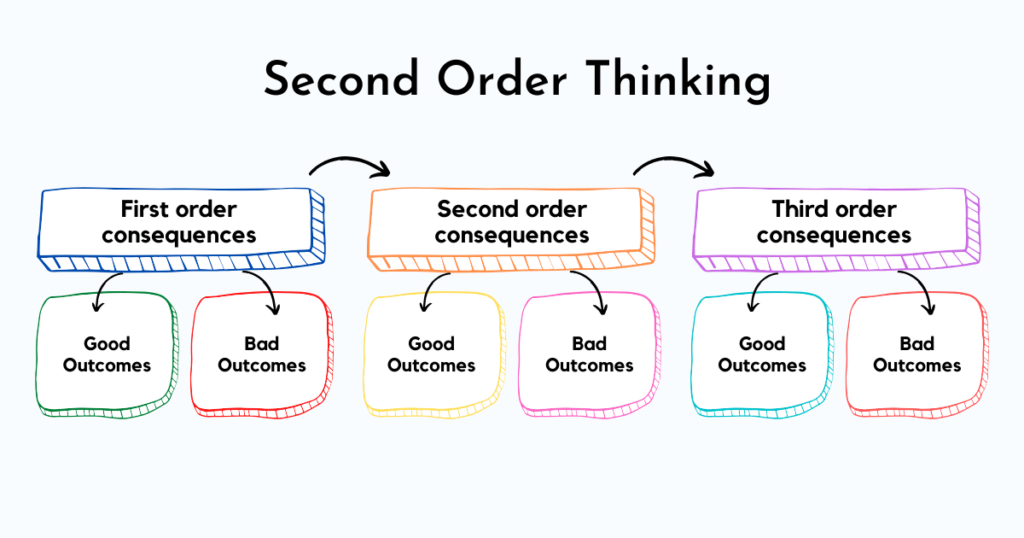Suspects of causation
The investigation into the primary cause of organizational dysfunction (OD) has been going on for a long time. When it comes to psychological matters like OD, causation is particularly troublesome. The human brain has far too many parts, constantly being created and destroyed, to prove cause of any cognitive act with certainty. What we do for proof of the cause of Plan B efficacy is to take a languishing Plan A organization, as-is, and transmute it to a flourishing Plan B, with a generic process. We claim the FLLP process is the cause of Plan B by implementation. Once available for live examination and evaluation, it’s up to others to controvert the claim.
The causes of Plan A OD are as many and diverse as its cascade of effects. The table below organizes our take on causes by second order and first order. These causes are demonstrable in your shop with your people. While your refusal to invite a demo does not refute the claim, it does implicate you as a typical causal agent of OD. No claim of the list as complete is made.
For OD, second order
- Attempts to defy Natural law
- 2½ (GIGO) Rule
- 36% turnover rule
- Lack of authentic responsibility for operational results
- Ca’canny, the response of the workforce to abuse, a form of sabotage
- Transparency no, opacity and deception yes
- Undiscussables
- Corruption hot bed
- Ineffective adult learning practices
- Stop rule violation
- Attempts to defy human nature
- Depersonalization, extrinsic motivation
- Inadequate control options (Ashby’s Law of requisite variety)
- Inadequate C/E knowledge and application skills
- Inappropriate decision-making by intuition
- No subconscious mind gatekeeping
- Oblivious to Plan B opportunities
- Positive reciprocity
- Competitive advantage
- Low administrative overhead

For OD, first order
- Establishment Norms
- Leadership by entitled authoritarians in their hierarchical role
- Failure to recognize and support the requirements of a flourishing organization
The difference in mental workload between first-level and second-level cognition is massive. The percentage of the population capable of the latter is tiny compared to the percentage of people capable of the former. First-level entitled consumers look for simple causation (e.g., greed) and simple effects (e.g., bankruptcy). Second-level producers know that success in goal seeking is never simple.

Second order causes of organizational dysfunction
These intermediate causes of organizational dysfunction, which deliver so many different kinds of consequences to the workforce, the stakeholders, and society in general, were derived by comparing Plan A operations to Plan B operations, same roster.
Each cause is generic and demonstrable. Every one of them has living veterans for you to interview. While, to the best of our knowledge the list is complete, there is no known benchmark of completeness. Accordingly, your contributions are encouraged. Whatever you come up with will be tested in the operational reality.
The A/B comparison also highlights those Plan B benefits in functionalities that don’t exist in Plan A life at all. The Plan A organization, incapable of fixing itself, is committed to progressive degeneration. There are hundreds of examples of this race to hell going on now in the governments of the world. They have no future.
The Plan B organization is futureproof. When Plan B gets hit with an unforeseeable disturbance, it does not have to change its operating practices to prevail. It’s just another day at the office for entropy extraction.
Attempts to defy the laws of the universe
It is amazing to observe people attempting to defy a law of nature, regardless of the obvious futility of their efforts. In recent centuries, science has established about two hundred laws of the universe, which by definition, are universal exactly because they cannot be defied. It appears that being able to defy a natural law conveys a sense that man has dominion over indifferent Nature. Funny, the man of today would not know how to use such a power to his advantage even if he had it.
In practice, mankind attempts to defy all sorts of natural laws. In organizational dysfunction, the entitled consumers are always trying to defy the 2½ rule (control theory). While everyone has played the telephone game, which is a demonstration of that law, authorities plagued with GIGO still try to bring prosperity to their organization by issuing executive orders. In practice, the only thing they get from that attempt is the imposter syndrome.
Attempting to defy the 36% turnover rule is a disregard of simple mathematics. In the case of turnover, it’s a first-order algebraic equation. This factor, impossible to fudge, is so powerful that once turnover is over 36%/annum, no other factor matters to producing the final outcome of the social system. That is why, exactly, the top priority of the A to B process is to reduce turnover of the keystones to background levels. This is done by personalization and meeting their intrinsic needs, the platinum rule.
The 1982 book “In Search of Excellence” by Peters and Waterman, was a long-running best seller and adored by the Establishment. In less than three years, half of the touted corporations had retreated to obscurity, exactly like the Malcom Baldrige prize for quality. This bold experiment answered all doubts about the powerlessness of the CEO to meet the criteria of “excellence” or quality.
The real lesson from this experience, totally ignored by science, is that head sheds don’t care about prosperity or quality of life. Their energies go into repeating practices proven to fail on a population of victims that accepts the abuse.
This website provides several examples of such pursuits of the impossible that are repeated generation after generation.
The matter of outcome responsibility
To predict the future of the organization, all you need to know is how it handles responsibility for attaining desired operational outcomes. If responsibility is assigned by management, there is no responsibility. If management claims responsibility, the 2½ rule makes it illegitimate. If management says everyone is responsible, no one is responsible.
Authentic responsibility can only be taken voluntarily by a keystone who has the autonomy to go where he must and do what he thinks best. Any time management assigns responsibility without granting autonomy, it destroys trust. The result is Ca’canny – a deliberate withholding of efficiency, a form of sabotage. Everyone has experienced this scenario, driven by human subconscious minds.
In Plan B, the workforce is encouraged to think of improvements. When the keystone grants the autonomy for workers to develop their ideas, taking legitimate responsibility, a satisfactory outcome is assured.
Transparency
What thinking process could there possibly be that delivers prudent choices by using politically-adulterated input data?
Opaque organizational operations, by itself, is a positive indicator of corruption. Organizations conceal their operations from inspection because it is dysfunctional, anti-stakeholder, devious. The flourishing Plan B operation proudly displays its operation and invites visitors for good reason. Flourishing is something for an organization to be proud of.
In the current version of business ethics in use, one side has all the obligations and the other side has all the entitlements. This is compatible neither with the ethics of interdependence nor with a universal code of ethics. It corrodes the bond of trust that ties superior to subordinate. Peter Drucker, 1977
Adult Learning
An organization that proactively supports adult learning methods proven to be ineffective, very common, signals its contempt of the workforce. Since the total cost of doing it conventionally, extrinsic, is far higher than using the best available technology, intrinsic, the indicating needle points toward authority-think. To who’s benefit is a poorly-informed workforce?
Stop rule violations
Every build of a Plan B organization begins with a written document given to management, listing the stop rules for the interventionist. One of them, of course, requires tolerance of effective adult learning practices. Should a stop rule be violated, the FLLP program is terminated on the spot and the interventionist withdraws from the engagement. There are no second chances. It’s not about incomes but outcomes. It is a duty we owe the keystones.
About one of every two engagements ends early because of stop-rule violations by management. The reason is always the dramatic improvement in productivity and morale brought by the program. Yes, that’s right, the imposter syndrome writ large. This counter-intuitive reaction is easy to demonstrate.
Attempts to defy human nature
Exactly like natural law, the inborn nature of Homo sapiens is invariant. While there can be great individual variations when acting in private, social behavior is genome-driven and dependably predictable regardless of cultures. Science fiction writers have never conceived of a different social arrangement for their aliens. When the emperor shows up, everyone defers to his whims.
The reliance on extrinsic motivational factors by management, when their counterproductive history in application is clear and consistent, makes for a long-standing puzzle. The cause of this imprudent behavior, we have surmised, is mostly due to the fact that using intrinsic motivational factors takes up time and effort for each individual. While psychological science offers several intrinsic factors that are general, and they make for a safe way to get started, it is essential to handle this one on one.
For the introductory meeting, we ask three questions about his preferences and commit his answers to memory. On the second meeting, we refer to at least one of his three previous answers. That takes care of any questions he may have had about your genuine concern for his welfare. It is the platinum rule writ large and always effective.
Inadequate cause and effect knowledge and application skills
A major thread of this website is the criticality of cause/effect knowledge for psychological success. When you have good C/E knowledge and experience in its application to handle complex problems and disturbances, you are futureproof.
For those who rely on their intuition to make choices for them, their miserable history with reality just adds to their fear of the future. The Establishment encourages this behavior. It’s exactly like the whales blowing bubbles to herd fish into a bait ball. It’s paying a high price to avoid the labor of thinking.
The futures of the individuals in the baitballs are grim. As you witness in these times, the media under Establishment control do little else but infuse fear into the public. Using their cause and effect knowledge makes a big difference to your anxiety level.
Inadequate control options
To satisfy Ashby’s law of requisite variety, it is necessary to know many cause and effect pairings. A form of feedforward control, his law says “if you wish to futureproof your system, you must have control options for whatever behavior the system may exhibit.” The search for future control needs, plausible disturbances to the system, is working from unwanted effects up towards candidate causes for the cascade of unwanted consequences.
Imprudent intuition
It is a serious blunder to allow your intuition to allocate your efforts on important matters. Intuition is located in your subconscious mind and whatever that awesome computer delivers is based on its storehouse of garbage-tainted information.
Oblivious to missing functionalities
When you’re coping with organizational dysfunction in Plan A, it’s impossible to consider how much is lost to the functionalities that are on autopilot in Plan B that don’t exist at all in Plan A. It’s one of the major distinctions between flourishing and languishing organizations.
Positive reciprocity is hands down, the most beautiful behavior in social relations. All parties are going by the platinum rule. Cooperation and collaboration allow the social system to take on projects no individual could handle alone.
Competitive advantage is not only great, it is achieved in a way their competition cannot emulate. It is the only patentable process that does not need patent protection to thwart theft of intellectual property. That’s why Plan B can be franchised.
Since many of the issues that consume large amounts of administrative effort in Plan A, like turnover, don’t exist in Plan B, the administrative workload is reduced accordingly. That is never a bad thing.
“In the current version of business ethics in use, one side has all the obligations and the other side has all the entitlements. This is compatible neither with the ethics of interdependence nor with a universal code of ethics. It breaks the bond of trust that ties superior to subordinate. Peter Drucker”
Checklist of first order causes of organizational dysfunction
- Failure to recognize and account for the inherent limitations of the top management role in creating organizational prosperity.
- Failure to recognize and account for the entitled authoritarians who attempt to defy their limitations and make matters worse.
- Failure to recognize and support the requirements of a flourishing organization.
To announce that the CEO is the villain in OD would be an easy and popular conclusion. Then, the primary cause could be stated as his greed and thus close out the investigation into root cause. Well, blaming greedy, sinister CEOs has been a favorite explanation for fallen societies for centuries and nothing at all has come of it. The question then arises, are you content to stop searching for your cause or do you want to fix the problem?
Organizational leaders cannot be the primary cause of organizational dysfunction. If that were true, the solution would be to select the CEO who has the necessary personal qualifications. Several centuries of failure trying out every personality known to science, put a cork in that approach. If you stop with your fallacious cause, the consequences continue. If you want to solve this monster problem, you can only do it by the process of elimination. That is how, exactly, the primary cause was identified in 2013.
The whole of the menace is caused by a society ignorant of and indifferent to the necessaries of a flourishing cohort. We can prove that cause as primary by fixing those causes and replacing languishing with a flourishing cohort while you examine and evaluate it in situ.
Your refusal to follow up on this paramount issue for you and your social system does not controvert the extraordinary achievement. Think about your refusal to engage. You have demonstrated the primary cause of OD to yourself. Done.
Visits: 107


